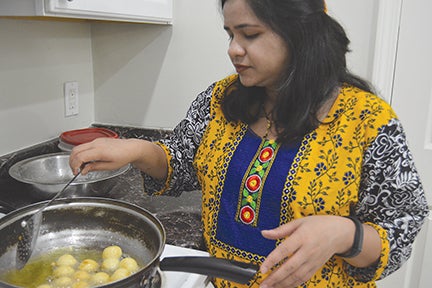Indians find ways to enjoy traditional cuisine
Published 12:00 pm Saturday, June 18, 2016
By Mrudvi Bakshi
news@oxfordeagle.com
Indians comprise a major chunk of the student population in Oxford. Thousands of miles away from home, in a quest to succeed in their academic and professional endeavors, they try to seek belongingness in their new homes.
Where adaptation is the key to surviving, certain habits are inherent in a way that can neither be changed nor substituted — the fondness for Indian cuisine being one such temptation.
With a combination of exotic ingredients, myriad varieties of dishes having incredibly fluctuating spice levels, Indian cuisine is that culinary experience which literally gives one the taste of the world.
Four years ago, Jagrati Jain was looking for a competitive doctorate program to apply from back in her hometown in Jhansi, a city in Uttar Pradesh of central India. Where on one hand she was busy juggling between books to clear the required entrance exams, her father was actively looking out for a perfect suitor for his daughter.
Four years later Jain is working as a research assistant at the Department of Molecular Sciences in the School of Pharmacy, and is happily married to the man chosen by her father.
Living in a comfortable three-bedroom villa off Greystone Boulevard in Oxford, Jain admits that although initially it was difficult to blend in due to the vast difference in the culture
and accent, she is content with the living the couple has made for themselves.
But it is the essence of those narrow lanes, the cheap and delectable food at cafeterias and piping hot karak chai (filter tea) at tea stalls of her hometown she misses the most.
Wholesome Indian food is an everyday must have for the Jains.
“I really wish there were more Indian food joints in the town or at least a grocery selling Indian foodstuff,” Jain said. “Being a staunch vegetarian, we are restricted to pizzas and pastas, and our taste buds saturated with the flavors of those, demand the tangy Indian spices time and again.”
Certainly not fans of American food, Jain has to design her work schedule every day in a way that she can take out time to cook, usually about an hour or two.
“It is hectic considering I have to leave for work at 7:30 in the morning, but cooking two meals is a must,” she said.
In order to maintain a balanced diet and ensure proper intake of nutrients, her everyday meal includes chapattis (whole wheat Indian tortia), dal (lentils, a good source of protein) and dry vegetables (greens).
Another source for getting great Indian food is the Jain’s association with the Indian Association of North Mississippi (IANM). A meet and greet for the Indians in Mississippi, the group frequently organizes pot-lucks and dinners during festivals and otherwise, creating a great medium to cook, serve and taste the variations the cuisine has to offer.
With the nearest Indian grocery located in Memphis, the Jains have a mandatory monthly or bi-monthly trip planned. For the love of greens and virgin vegetables, they have dozens of things growing in their garden. Cucumber, Indian squash, potato, okra, lemon grass, mint leaves, red and white radish, eggplant and curry leaves are among the few growing in their backyard.
“Undoubtedly for us Indian food gives us a sense of satisfaction,” Jain said. “Some amount of time, maintenance and presence of mind can make it less cumbersome.”
Creating substitutes for food not readily available is something Jain has learned over her time in Oxford. Her quick tip for those looking for condensed dry milk used in a lot of Indian savouries and not available locally is to use mix powdered non-fat milk with heavy whipped cream.
With a supportive husband, Jain feels encouraged to cook, despite days of long working hours.
“Although there are those untimely cravings of food only found back home, having built our living here, with time it’s only prudent to learn to adjust with your surroundings,” Jain said.
Gulab jamun
Gulab jamun is easily the most popular and loved dessert in India. Gulab jamun is best described as an Indian version of a donut immersed in a sweet syrup. It is both decadent and delicious.
Will serve 8
Preparation time – 15 minutes
Cooking time – 20 minutes
Recipe will make 16
Ingredients
• 1 cup nonfat milk powder
• 1/4 cup all purpose flour (plain flour, maida)
• 1/8 teaspoon baking soda
• 1/2 cup heavy cream, use as needed
• 1/4 teaspoon cardamom coarsely ground
For syrup
• 1-1/4 cup sugar
• 2-1/2 cup water
Other
• Oil to fry
Method
For syrup
Add water, sugar in a pan. Stir until the sugar has dissolved. Bring it to boil, turn off the heat and keep it aside
For gulab jamun
Add milk powder, all-purpose flour, baking soda, and cardamom in a bowl, mix it. Add cream and mix it well too. The consistency will be like soft dough. Cover it for 10 minutes. If dough is tight add 1 to 2 spoons of milk. If its sticky add milk powder.
Grease your palm and knead the dough and divide it into 16 equal parts and make ball of it.
Heat the oil in a pan. The heat should be medium and pan should have at least 1 inch of oil. Test the temperature of oil by placing a small piece of dough into oil. The dough should rice within 30 seconds. If it rises faster than this, it is too hot.
Place the balls in the pan. Gulab jamun will expand double in size so don’t over crowd.
It takes about 8 minutes to fry gulab jamun. While frying, make sure to roll them so that they brown evenly.
Remove the gulab jamun from oil. Put in a plate on the tissue paper so the extra oil is removed. Let them cool off for few minutes (7-10 minutes).
Place them in warm or hot sugar syrup. Let them sit for about 45 minutes before serving.






